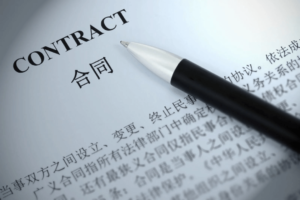Companies looking to manufacture their products in China face a significant challenge: protecting their intellectual property (IP) against unauthorized use, copying, or infringement. A combination of legal strategies and proactive measures is key to safeguarding your designs, molds, and proprietary processes. This article explores the essential steps for securing your IP rights when engaging with Chinese manufacturers, including the importance of manufacturing contracts, IP registration, and strategic planning.
Table of Contents
ToggleUnderstanding the Importance of a Solid Manufacturing Contract
The foundation of your IP protection strategy should be a robust manufacturing contract tailored to the Chinese legal environment. This contract must explicitly prohibit the manufacturer from copying your molds, using them for any purpose other than producing your products, creating derivative products based on your designs, manufacturing for your competitors, or directly selling to your customers. To ensure enforceability and clarity, the contract should include Non-Disclosure, Non-Use, and Non-Circumvention (NNN) clauses. These clauses collectively work to prevent the unauthorized dissemination and use of your IP.
A crucial aspect of your manufacturing contract is its language. The contract should be bilingual, with both Chinese and English versions available. This ensures the terms are clear and enforceable in the jurisdiction where they will be applied. However, it’s important to note that in the event of a dispute, the Chinese version of the contract will hold greater legal weight in Chinese courts. Therefore, it is indispensable to have a contract drafted or reviewed by legal professionals with expertise in Chinese IP law.
The Role of IP Registration in China
Beyond a manufacturing contract, registering your intellectual property in China is a critical step in protecting your assets. China operates on a first-to-file system, meaning that the first party to file for a patent or trademark in China holds exclusive rights to that IP within the country. This system significantly differs from those based on a first-to-invent principle, making early registration essential for protection.
We recommend registering your designs and molds as design patents in China. This registration grants you legal recourse in the event of IP infringement, providing a governmental acknowledgment of your ownership. Additionally, consider trademarking your brand name and logo to safeguard your market identity.
Timing and Budget Considerations
When planning your entry into Chinese manufacturing, it is wise to prioritize IP protection before initiating contact with potential manufacturers. The first-to-file system necessitates securing your IP rights as soon as possible to prevent any third-party registrations that could jeopardize your ownership.
Budgeting for IP protection should be an integral part of your project’s financial planning. Although it represents an upfront cost, investing in comprehensive IP security measures can prevent significant losses and legal battles in the future.
Seeking Legal Advice
Given the complexities of IP law and the nuances of the Chinese legal system, consulting with legal professionals specializing in Chinese IP protection is highly recommended. Legal experts can provide guidance tailored to your specific situation, ensuring that your contracts are robust and your IP registration is correctly filed. They can also offer invaluable advice on navigating the legal landscape in China, helping you to avoid common pitfalls and protect your interests effectively.
Navigating IP Ownership and Mitigation of Unauthorized Replication
In the intricate dance of securing your intellectual property (IP) rights for manufacturing in China, an essential step often overlooked is verifying the current status of IP ownership within the country. This precaution stems from the reality of China’s first-to-file system, where preemptive registrations occasionally mar the landscape. Such actions can leave foreign innovators in the cold, discovering their creations are legally owned by others in China, despite being the original inventors.
The Reality of Unauthorized Use and Production
A critical insight to bear in mind is the tendency among some Chinese manufacturers to exploit the designs and molds shared by foreign companies. It’s not uncommon for these resources to be used not only for the intended production runs but also for creating similar products either for the manufacturer’s own benefit or for sale to competing entities. This practice not only fragments your market presence but also erodes the integrity and perceived value of your brand.
The Imperative of Ensuring IP Clearance: Detecting Potential Infringements Early
The pivot towards securing your IP rights in China must include a comprehensive search to ascertain that another party has not already registered your designs, patents, or trademarks. This step is paramount before diving into discussions or agreements with potential manufacturing partners to avoid falling victim to the first-to-file system without recourse.
Integrating this strategic verification process as a concluding step in your approach to IP protection harmonizes with the earlier emphasized measures. Drafting a manufacturing contract with robust NNN clauses, pursuing timely IP registration, and seeking adept legal counsel form a fortress around your intellectual creations. However, ensuring that your innovations are free from prior claims in China is the keystone that completes the arch, providing a solid foundation for your manufacturing ventures in this dynamic market. This holistic strategy not only shields your IP from unauthorized use and competition but also fortifies your position in the global marketplace, ensuring that your entry into Chinese manufacturing is marked by innovation safeguarded with diligence.
Conclusion
Manufacturing in China offers numerous advantages, but it also requires careful planning and strategic measures to protect your intellectual property. By drafting a detailed manufacturing contract with NNN clauses, registering your IP in China, and seeking specialized legal advice, you can secure your designs, molds, and brand identity against infringement. This proactive approach not only safeguards your assets but also ensures a more stable and trustworthy relationship with your Chinese manufacturing partners.
FAQs
What is a manufacturing contract and why is it important for IP protection in China?
A manufacturing contract is a legal agreement between a foreign company and a Chinese manufacturer that outlines the terms of production. It’s crucial for IP protection because it can include specific clauses (NNN – Non-Disclosure, Non-Use, Non-Circumvention) that prohibit the manufacturer from copying, using, or distributing your designs and molds without authorization. This contract serves as a foundational layer of legal protection for your intellectual property in China.
Why should the manufacturing contract be bilingual?
The manufacturing contract should be bilingual, with Chinese and English versions, to ensure clarity and enforceability in China. Since Chinese courts will rely on the Chinese version of the contract in legal disputes, it’s imperative that this version accurately reflects the agreed terms. If both language versions are legally verified according to Chinese laws, the bilingual contract helps mitigate misunderstandings and legal risks.
Because of differences and laws, Chinese courts rarely follow judges from foreign courts. Therefore, choosing jurisdiction in China is more efficient and makes contracts easier to enforce in China. This is important when one enters into an agreement with a company in China.
What does IP registration in China involve?
IP registration in China involves officially filing your designs, patents, or trademarks with the Chinese government. This process grants you legal recognition and protection under Chinese law, allowing you to defend your IP against unauthorized use or infringement. Since China operates on a first-to-file system, timely registration is critical to securing your rights.
Why is it recommended to register IP before contacting manufacturers?
Registering your IP before contacting manufacturers is advised due to China’s first-to-file system. This system awards IP rights to the first party to file for them, regardless of who actually created the design or product. By registering your IP early, you ensure that you hold the rights to your designs in China, preventing others from filing before you and potentially stealing your IP.
How does the first-to-file system affect IP protection in China?
The first-to-file system in China awards IP rights based on who files for them first, not on who invented or created the design or product. This means that if someone else registers your design in China before you do, they legally own the rights to that design within China. This system makes early registration of your IP crucial for protection.
What role do legal professionals play in protecting IP in China?
Legal professionals specializing in Chinese IP law play a critical role in navigating the complex legal landscape of IP protection in China. They can assist in drafting enforceable manufacturing contracts, ensuring proper IP registration, and providing strategic advice on protecting your assets. Their expertise is invaluable in avoiding common pitfalls and effectively safeguarding your intellectual property against infringement.








